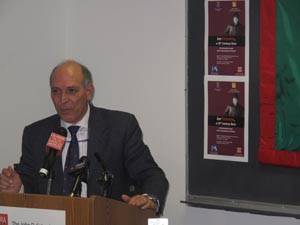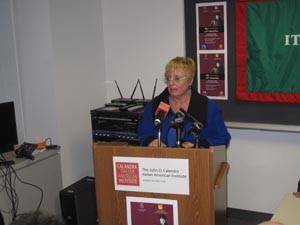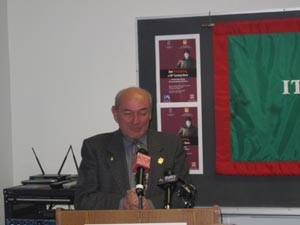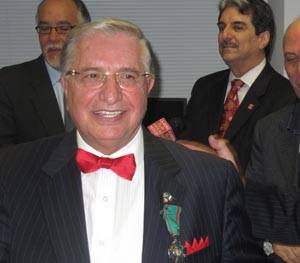Documenting Joe Petrosino to Keep His Memory Alive
Who killed Joe Petrosino? What were the circumstances of his murder? For a century or so these questions were left with no answers. All the documents concerning the investigations on the homicide had been kept secret in the State Archives. Today they were revealed thanks to the efforts of the Province of Palermo and if justice can not be done anymore, at least a due homage can be offered to the Italian-American policeman who was gunned down in Palermo in 1909 while investigating the connections between the Italian and the Italian-American Mafia and Public Institutions.
Just this summer an exhibit featuring unpublished documents, reports and testimonials was held in Palermo during the whole month of August. It received huge attention by the local population and the media. On the occasion of the Italian Cultural and Heritage Month, it was brought here and will be hosted at the John D. Calandra Italian American Institute throughout the middle of November.
The exhibit documents Petrosino’s visit to Palermo and the complex investigations following his homicide. It opens with a series of documents describing the moment in which his body was found and continues with a collection of evidence, as it was assembled by the Italian Carabinieri and Police, that fully describes his journey from New York to Palermo.
The display goes on to show documents concerning his funeral and the transportation of his body from Palermo to New York. Finally, the consistent correspondence between the NY Police Authorities and the local police in Palermo informs us about how the complex unsuccessful investigation, which was archived shortly after, evolved.
The exhibit “Joe Petrosino, a 20th Century Hero - A documented account of his assassination in Palermo” was inaugurated on October 16 at the Calandra, together with the presentation of the book “Documenta Joe Petrosino” by Anna Maria Corradini, 800 copies of which will be available for free for the visitors to the exhibit.
The event was one of great success, and received great public attention. The Dean of the Calandra Institute Prof. Anthony J. Tamburri introduced the distinguished guests who were present and who followed each other onto the podium to give their speeches and greetings.
Consul General Francesco Maria Talò talked about Petrosino as of a hero of our century. “It is important to understand the figure of Petrosino and realize how he was perceived at that time. When he was still alive, he was already a hero for his people. He started his career in the Sanitation Department and became lieutenant in a very short time. This is also a demonstration that the NYPD, which was led by the President of the United States to be Theodore Roosevelt, was working well and gave the right responsibilities to the people who deserved them. Shame on Italy and Sicily for what happened to him”.
The Province of Palermo was represented by its President Giovanni Avanti and a good number of the members of the City Council. By defining Petrosino the “first martyr of the Mafia”, Hon. Avanti explained to us that the idea for the exhibition was first conceived during the Columbus Celebrations of 2008 in New York. “When we got back to Palermo we realized that in Italy very few people knew about this person who was very important for the relationship between the United States and Italy. He came to our country to die, so we felt we had to do something to praise his efforts to defeat the Mafia. That’s when we started collecting all the documents from the Regional Public Library and the National Archives in Palermo. Nobody had done it before and we decided to organize them in this important display.”
Petrosino was not only the first of a long number of Public representatives to be killed by the Mafia, but most of all he was an Italian, who like many other Italians and even more, contributed to the growth of American society, as Mr. Avanti continued. “He represents in the eyes of Americans the people of Italy, which is one, unique, and unified. And that’s why the Province of Palermo has found strong support in the city of Padula, his birth town, for the organization of this exhibit”.
The mayor of Padula, Giovanni Allegria, was also there : “I am here to pay homage not only to Petrosino, but also to the Province of Palermo that is doing so much to keep his memory alive. This book and the exhibit displayed here are only two examples of a major effort that has been carried on in the last period that aims to spread the principles and values of legality well outside the mere borders of Sicily.”
After the official remarks delivered by the Chief of the New York Police Department George Grasso and the director of the Central Library of the Sicilian Region Gaetano Gullo, “the institution called to preserve and spread the culture of the region”, Joe Petrosino’s great-nephew Nino Melito gave his very personal speech, and told us how important the presence of such a figure in his family has been to him. He is proud to live in Padula, where the only House / Museum in Italy dedicated to a policeman, his ancestor, is located. He personally collaborates with the museum, and openly invited all of us to visit it. He usually accompanies the tourists through the rooms of the house, telling the story of his family to all those interested.
The conference was also enriched by the speeches of two eminent representatives of the Italian-American academic world, the Vice-President of Saint John’s University Prof. Cav. Joseph Sciame and Professor Fred Gardaphe.
Himself a Sicilian, Cav. Sciame insisted on the role Petrosino should have to unite Italian and American people. Saint John’s University, as he told us, is strongly committed to the preservation of the memory of Petrosino and to the teaching of the basic principles of law to its students. As the President of the Italian Heritage and Cultural Committee, Cav. Sciame also showed us the poster portraying Petrosino that has been widely diffused throughout the city of New York in all those venues in which Italian culture is studied and promoted at different levels, and in all the centers directly committed to the promotion of legality.
Prof. Fred Gardaphe, finally, gave us a retrospective on the representation of the Italian Mafiosi in the history of Italian-American cinema. He reconstructed the historical and social circumstances in which the stereotype of the Italian man as “gangster” was first created, and the way it has evolved in decades of Hollywood cinema. He finally wondered what direction this path will take: “Will Italian American culture develop to the point where Mafia men will be buried for good? Up until this point, Italian America has often been defined by the mafia, but in the face of contrary evidence, what we do in response to the myth of Mafia men will define us and determine the future of our community and identity as Italian Americans. If we seriously invest in education and the arts this could be the end of Mafia men, and the beginning of a renaissance of Italian American culture.”, he concluded.
The conference at that point was about to be end. But there was a final surprise, a moment of great joy for the small town of Marineo (Sicily), represented on this occasion by its former mayor Ciro Spataro. Cosimo Sanicola, who emigrated from Marineo at the age of 13 when his father died and settled in New York, was given by the Consul General Francesco Maria Talò the title of Knight of the “Ordine al Merito della Repubblica Italiana”.
A short time after his arrival in the US, Cosimo bought and ran a bakery, and quickly became a very successful business man. But he never forgot his hometown and he financed with great generosity the reconstruction and modernization of some of its landmarks, such as the Church of Saint Anna. Besides assisting the poorest families of Marineo, this year he also financed the “Dimostranza”, the four-yearly festival organized by the town in honor of its patron Saint Ciro. With a very touching speech in which he expressed all his gratitude towards the President of the Italian Republic represented by Consul Talò and his hometown, Cosimo ended the conference allowing all of us to take a tour in the exhibition gallery.
While enjoying a full and satisfying Italian banquet, we had a chance to take a look at the incredible number of documents displayed and, of course, to grab a copy of Anna Maria Corridini’s book “Documenta Joe Petrosino”.
















































i-Italy
Facebook
Google+
This work may not be reproduced, in whole or in part, without prior written permission.
Questo lavoro non può essere riprodotto, in tutto o in parte, senza permesso scritto.